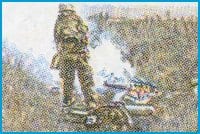Like the best kind OFseductress, Stephen Andrews has point and purpose. Just how seductive his artistically and politically potent work can be is evident at the University Of Toronto’s Justina M Barnicke Gallery. Culled from Salah Bachir’s private collection and spanning 15 years, the Stephen Andrews show presents a unique opportunity to trace Andrews’ artistic evolution as he continues to spin web after brilliantly constructed web enmeshing the personal, the political and the aesthetic.
Curator Sarah Stanners has assembled a thoughtful, comprehensive tour of artistic obsessions — queer identity and desire, AIDS, the viral proliferation of media imagery — from which Andrews has built an international career. The show reads like a greatest hits collection, from the photocopy-on-latex gay erotica of the early 1990s (not in the best condition, sadly) and the 1996 rainbow silkscreens “Parenthesis (No Gold),” — an elegiac musing on the then-emergent AIDS cocktail drug therapies — to his most recent crayon-rubbings of photographic dispatches from the current Iraq war, including his monumental foray into cell animation The Quick And The Dead (presented alongside its accompanying minute-long animated sequence).
The Quick And The Dead series is, for my money, the clear centrepiece of the show: the 192 individual drawings, hung side-by-side and floor-to-ceiling, are an overpowering sight, occupying an entire wall of one room. It also speaks most clearly to Andrews’ project of valorization and memorialization.
“[I assume] the role of a curator/correspondent, trying to piece together the story from all these different bits of information,” says Andrews. “It’s selecting these images out of the trash.”
The Quick And The Dead focusses our attention on the gruesomeness that has, thanks to the comfortable distance that TV news snippets afford, become banal and mundane (although the source imagery for the series is taken from video never broadcast to the public). Andrews says he transforms these images into “hard copy.”
“The virtual image is just bits and bytes, you know, zeros and ones; it doesn’t really exist. So it’s about making this thing manifest in some kind of way, in a medium that is assumed to have value… it’s supposed to stick around for posterity if it’s art.”
Andrews never editorializes; he rightly trusts his images and the power of conceptual transparency, and so presents us with nothing but the scene itself. We are forced to watch, frame by frame, the disasters of war, in this case, a US soldier putting out the fire of a bombing, gingerly stepping over a gored naked body to do so. His casual demeanour coupled with the splayed nudity of the victim is chilling, and watching the scene play out again and again in the accompanying video loop makes it even more so. By telling the story through gorgeous formal aesthetics (the wispy fogginess of the crayon rubbed over the skin-like parchment paper) and unflinching reportage, Andrews is working in Goya territory.
Like any good seductress, Andrews is careful not to be held down, and sidesteps the pigeonhole designation of “political artist.” “I consider myself political and I’m an artist. I don’t think I produce propaganda. I mean, I’m looking at the production of ideological imagery.
“We’re living in this particular time, and why wouldn’t you represent that as an artist?”
Andrews recognizes that for images to have power, they first have to lure the viewer. “What I’m trying to do is give a little sugar with the medicine, so that you can let the horror of them seep in, and maybe do something about it, even if that’s talking to people who don’t agree.”
Andrews’ work is rooted in more than just seductive presentation. This beauty has brains. There is a careful consideration paid to how the formal aspects of a work (materials and medium) inform the image. Ultimately, what makes his war drawings so interesting is their reference to print-news images: In addition to limiting himself to a newspaper’s printing palette (layers of cyan, yellow, magenta and black), the colours are rubbed on through a screen, effectively reproducing the Benday dots of periodicals. Andrews is giving this unseen, officially ignored imagery a material presence. His imagery may be poker-faced, but his deft presentation offers a scathing critique of mainstream media that has kowtowed to a party line, obscuring rather than illuminating. Silence equals death, and Andrews gives the awful truth a human voice.
Another example, “Parenthesis (No Gold),” is a wry, disillusioned statement on the promises of AIDS science. It consists of two screenprinted rainbows done on sheets of pig-intestine, their arcs arranged so that they enclose a giant empty space on the wall (hence the title). This seemingly odd material choice references medieval augury (the art of predicting the future by looking at animal entrails). The poignancy of “Parenthesis” comes mainly from the yawning emptiness framed by the twin symbols of hope. It also derives from the slips in the silkscreening process: The layered colours, instead of sitting perfectly atop each other to form a coherent image, are always slightly out-of-sync. The rainbows promise utopia, but the image’s imperfections suggest its impossibility.
Despite being in only two rooms large, the show is expansive. What emerges is a sense of a tireless engagement with personal circumstances and obsessions, and how best to turn them into art. “I’m making this beautiful thing. But it has ramifications in the natural world and people’s relationship to the natural world. That’s what I’m most interested in: People’s relationship to the environment, both political and physical.”

 Why you can trust Xtra
Why you can trust Xtra


